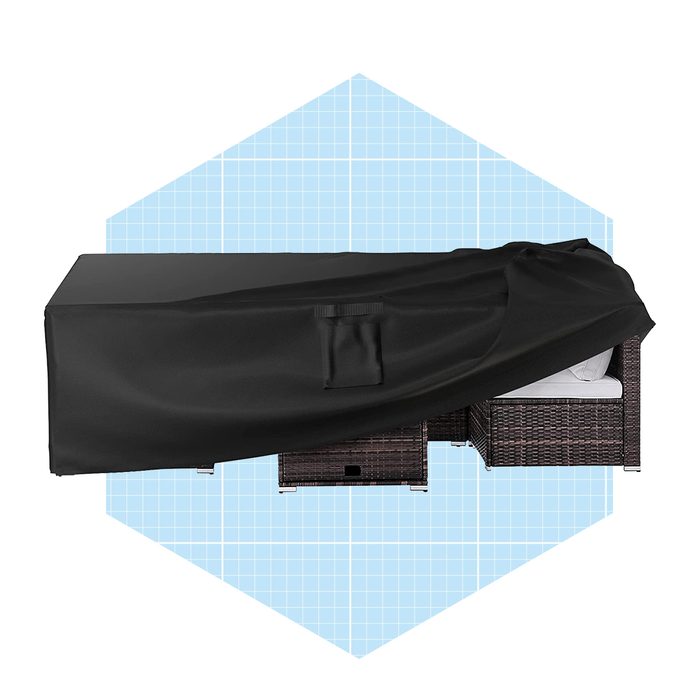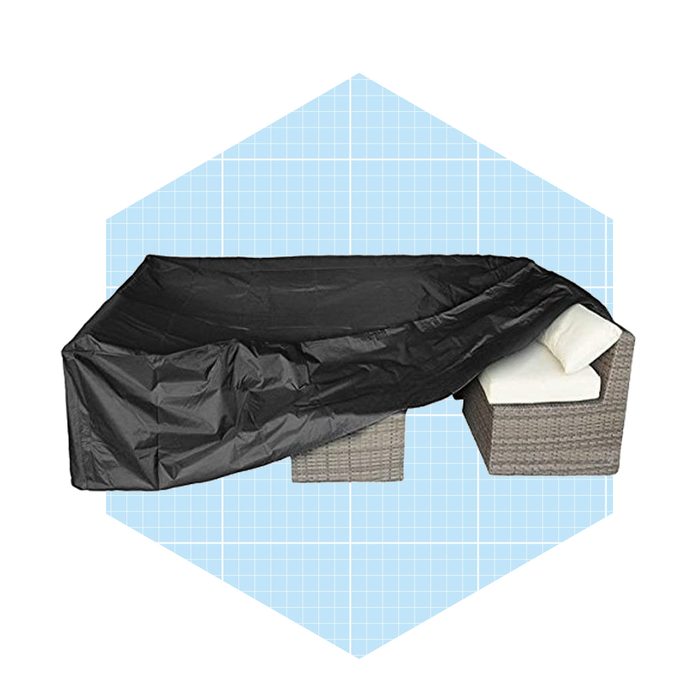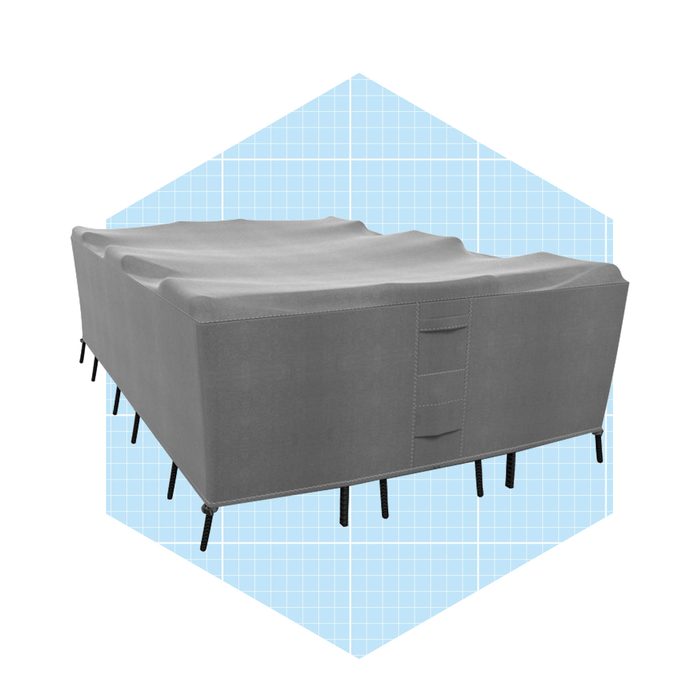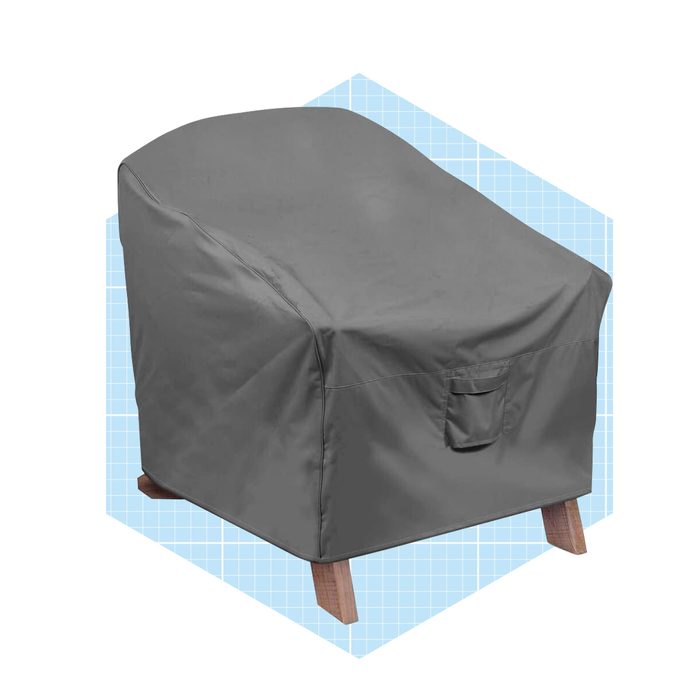via merchant
via merchant
Pros:
-
Water-resistant and UV-stabilized coating
-
Features a double-secure system
-
Has broad padded handles
-
Available in two colors and one- and two-packs
Cons:
-
Only available in one size
We all know Adirondack chairs are often bought in pairs, which is why these outdoor chair covers come in a single- or double-pack. Its oxford fabric is coated with a water-resistant, UV-stabilized coating. A laminated backing arms these chair covers against water seepage and all kinds of harsh weather. A double-secure system—adjustable cord with toggles and click-close straps on an adjustable belted hem—keeps the covers secure regardless of wind. Broad padded handles make installing and removing your Adirondack chair cover a breeze.
Types of Patio Furniture Covers
When selecting patio furniture covers, consider these types:
- Universal Patio Furniture Covers: These covers work well for furniture that doesn’t fit standard dimensions or for grouping multiple pieces under a single cover. If you have specific measurements or the exact make and model of your furniture, you might also explore more tailored options.
- Patio Dining Set Covers: Covering an outdoor dining table helps prevent warping, fading and cracking, even if it’s made of weather-resistant materials. This is particularly important for maintaining the table’s finish and prolonging its lifespan.
- Patio Conversation Set Covers: For upholstered outdoor furniture, choose covers that protect against moisture to combat mildew, dirt and debris. Look for sets that include multiple pieces to cover each item, or opt for a universal cover to shield all the pieces together.
These different options allow you to protect various outdoor furniture setups effectively.
What to Consider When Buying Patio Furniture Covers
Getting the correct fit and size for outdoor furniture covers is essential for protecting your investment from the elements.
Fit and Size
To ensure the best fit for outdoor furniture, measure its width, length and height and decide if you prefer individual covers for each piece or one large cover for a whole set. Undersized covers expose parts of the furniture, risking weather damage, while oversized covers can look awkward and may be more prone to blowing off in windy conditions.
Double-check the dimensions of your furniture and compare them to the listed measurements on the cover before making a purchase. This will help you find the ideal fit to keep your furniture well-protected and looking its best.
Material Quality
When choosing outdoor furniture covers, the material significantly impacts performance, durability and price. Here’s a rundown of the main options:
- Vinyl: Lightweight and affordable, vinyl provides basic moisture resistance, making it an economical choice for indoor storage or light outdoor protection. “Vinyl is perfect if you need to store your patio furniture inside,” says Hull.
- Polyester: Known for its strength and versatility, polyester is UV-protective, breathable and resistant to water, mildew and mold. While it may cost more than vinyl, polyester offers superior all-around protection. “Polyester covers are generally better than vinyl in any climate or situation,” says Hull.
- Canvas: Best for sunny climates, the canvas is heavier and typically treated to resist water and UV damage. It can handle significant weather exposure, especially in areas with intense sun. “The UV resistance makes it a top choice for regions with high sun exposure, and it stands up well against tougher weather,” notes Hull.
Choosing the right material depends on your specific needs, climate and budget.
Waterproofing and Weather Resistance
When selecting outdoor furniture covers, consider the environmental factors that could affect your furniture. If you live in a climate with limited snow and ice but frequent rain and intense sun, focus on UV protection over waterproofing. Alternatively, to shield your furniture from bugs, animals or bird droppings, opt for covers that offer a comprehensive barrier against these elements.
“Most patio furniture covers are designed to withstand diverse weather conditions,” Hull says. He emphasizes the importance of investing in high-quality covers to avoid frequent replacements. “Choose waterproof covers made from durable fabric to prevent costly mistakes and ensure long-lasting protection.”
Ease of Use
When choosing outdoor furniture covers, ease of use is crucial. If covers are hard to put on, you’ll be less inclined to use them regularly. It gets frustrating when they come loose or blow off in windy conditions. Look for features like Velcro straps, zippers and elastic hems that secure covers, making them easier to use and more effective at protecting your furniture.
Breathability
“Breathable means that the moisture can leave, so you won’t end up with a disgusting mold or mildew problem on your furniture,” says Hull.
Some covers include vents for breathability, and polyester covers also allow airflow. You need a balance—waterproof enough to protect but not so much that moisture gets trapped inside.
Duration of Use and Aesthetics
When selecting outdoor furniture covers, consider how you plan to use them and for how long. Are they for seasonal protection during fall and winter, or will you cover your furniture daily after use? If frequent on-off use is likely, prioritize covers with easy access and storage features. Also, check for warranties and guarantees to ensure they meet your durability expectations.
Aesthetics play a role, especially if you use the covers for extended periods. Since they’ll be visible to you and your guests, choose options that complement your outdoor space while maintaining functionality.
Why You Should Trust Us
Patricia Shannon is an experienced freelance writer and former Senior Editor at Southern Living, specializing in home, garden, beauty and culture content. She has covered various products, including front door awnings and camping bags. Her background in outdoor product research guides her in curating the best patio furniture covers.
For this article, we consulted Tyler James Hull, owner of Modern Exterior and Bubblegum Flooring. With over a decade of experience in residential construction—including managing major projects like The Rock Sports Complex, The AmFam Amphitheater and Foxconn—his expertise in home improvement proves invaluable in creating this guide.
Sean Tirman, Content Updates Editor at Family Handyman, updated and contributed research to this piece. Sean has written shopping guides since 2016 and is a former associate editor at Gear Patrol.
How We Found the Best Patio Furniture Covers
To find the best patio furniture covers, we first examined typical materials, protection levels, appearance and cost. We considered dozens of options to recommend those truly worth your time. We evaluated each cover’s quality, durability and longevity, paying close attention to professional and user reviews. Finally, we consulted a home improvement expert to finalize our list.
FAQ
How do I measure patio furniture to get the right size cover?
Use a flexible measuring tape to measure each item’s height, width and depth. Measure from the top point to the ground for the height, and account for any curves and angles. This ensures the cover wraps comfortably without stretching. Double-check your measurements to be sure.
“Then, add an inch or two to every dimension,” adds Hull. “This little bit of wiggle room means the cover won’t be too snug and should prevent any tearing, not to mention making it a snap to put on and take off.”
How do I maintain or clean patio furniture covers?
“Keeping patio furniture covers clean is quite basic, so keep it simple and don’t overthink it,” says Hull. Typically, you can keep them clean by brushing off any loose debris. It’s also a good idea to clean them between seasons with warm water, light soap and a bristle brush.
Hull adds, “Let them dry completely before putting them back on your furniture. You can also store them away until next season. That way, they won’t start growing mold or mildew in some of those damp corners.”
Should patio furniture covers touch the ground?
Patio furniture covers should sit a few inches above the ground to allow proper airflow and protect them from pooling water.

























